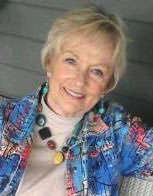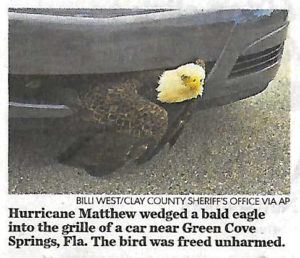
Matthew, the Hurricane, Meets A Course of Love
By Paula Payne Hardin
October 14, 2016
There is an afterglow bathing my community of Vero Beach, Florida. The Category 4 hurricane named Matthew, due to make a direct hit sometime during the night of October 6 through 7, wobbled, just off our coast and veered out to sea 20 miles. Local newspapers called it a “Kiss from God” and “. . . an unforeseen gift from Mother Nature.” The Press Journal said “If there is such a thing as an ideal encounter with a Category 4 hurricane, our region experienced it Thursday night/Friday morning. We can all breathe a collective sigh of relief. Whew! But let’s be clear: This story easily could have had a different—and tragic—ending.”
You might ask what does this have to do with the Course? Here goes. I have been immersed in chapter 20 of the Course titled The Embrace, for a couple weeks, letting its revelatory wisdom sink deeper and deeper into my heart, my core. When I came to verse 38, I found I needed to make a list (I do love lists) in order to let in its truth fully. I titled the list “HOPE IS,” then read and reread it, absorbing its worldview.
Hope is a manner of acting as if the best possible outcome you can imagine could truly occur.
Hope is a willingness to accept love and the grace and cooperation that flow from love.
Hope is a willingness to ask for help, believing it will come.
Hope is the reason and outcome for which we pray.
Hope acknowledges the kindliness of the universe and has no use for things.
The inanimate as well as the animate is called upon, depended upon, for service.
All use is replaced with service,
. . . and appreciation replaces the callousness with which use once occurred.
When the news broke that our area needed to evacuate because Matthew was predicted to make landfall right here I felt frozen at first. It can’t be! I won’t go into all the scurrying about, the emergency shopping, making arrangements to stay in a friend’s apartment a few miles inland, gathering necessary records, having my home boarded up, moving outdoor things indoors. Saying goodbye to my home and gardens, thanking them for their service, then packing the car and hauling everything to a safer place on a second floor. I had lots of help, but still!
 Each time fear crept in, night or day, I’d grab my HOPE list and read it out loud to myself first of all, then to anyone who wanted to hear. Soon an image came to me of the eye of the storm veering away from our coast and out over the ocean. This image stayed with me. I prepared for the worst and visualized the best.
Each time fear crept in, night or day, I’d grab my HOPE list and read it out loud to myself first of all, then to anyone who wanted to hear. Soon an image came to me of the eye of the storm veering away from our coast and out over the ocean. This image stayed with me. I prepared for the worst and visualized the best.
Darkness descended Thursday afternoon. My sister and I watched the weather channel. We didn’t know what to expect. But I had a peace in my heart that I couldn’t understand. I knew we were safe. I knew all was well whatever happened.
The winds picked up, the rain hurled itself from the skies, the trees bent. I felt a peace and curiosity about what was happening around us. The power went out. No toilet flushing, no opening the refrigerator or freezer. We were cut off except for our cell phones. We were careful—we didn’t want to use up their batteries. We lit a few candles.
In bed, dozing, a childhood song began to sing me: “Safe in the arms of Jesus, safe on this gentle breast.” Over and over it sang. At first when it arose, I noted my old, lurking resistances. “Too sentimental for my taste.” I even noted a bit of old resistance to the word “Jesus.” As I grew more aware, I confessed my unwillingness to accept love and the grace and cooperation that flow from love. I let it all go. And the song sang on through the blowing night.
Entry in my journal the next morning: “I released all resistance last night, I affirmed my willingness to accept love, to accept the comfort of resting on Jesus’s love-breast. This morning I recall the night’s tenderness with tears and a deep relaxing.”
Then my adult children, who had been keeping vigil and watching weather reports, texted me that CNN said a big shift came and the winds reduced from around 130 mph to 70 mph. The hurricane forces were weakening. WOW! Who could have hoped for anything more?
Is it too grandiose to link celestial events with my consciousness? The following day I again read Chapter 20, The Embrace, and I noticed this in paragraph 46: “Before you begin to resist the notion that you could have anything to do with world peace (or I might add with hurricanes calming down), realize that you naturally have reacted with resistance. You must replace your willingness to believe in your inadequacy and smallness with your willingness to believe in your ability and mightiness. Remember not your ego concerns and remember instead the warmth of the embrace. Remember not your personal identity but remember instead your shared identity.”
I give thanks for the profound experience of peace during the lead-up and into now, with the clean-up. I take in the tenderness that comforted and surrounded me. It’s a pleasure to be me, transforming!
Paula Payne Hardin appeared on the Oprah Winfrey Show when her first book, “What Are You Doing With the Rest of Your Life? Choices in Midlife” appeared in 1992. She is also the author of “Love After Love: Stages of Loving” (1996).
God’s Enjoyment of My Soul
By Elliott Robertson
What took me by surprise
was God’s enjoyment of my soul–
the love God has for me is never ending.
The angels dance with mirth
when I embrace my Lover.
They pluck their harps with glee
when I give the One a furtive glance.
From where you sit, O God,
my humble soul is most important–
like earth and roots belong to rain,
so too does my soul belong to you.
What took me by surprise
was God’s enjoyment of the Christ–
God wants my soul to open
to the truest love.
The angels are delighted
when I call God, “My Beloved.”
They fall down to their knees
when I embrace the wind with love.
They praise the One who gives all power to creation.
Yes, in giving of True Essence God receives.
Elliott Robertson lives in Philadelphia, PA. His most recent book of poems, Taken By Surprise, is available from the Kindle Store at Amazon. Searching the Kindle Store under the author’s name works best.

